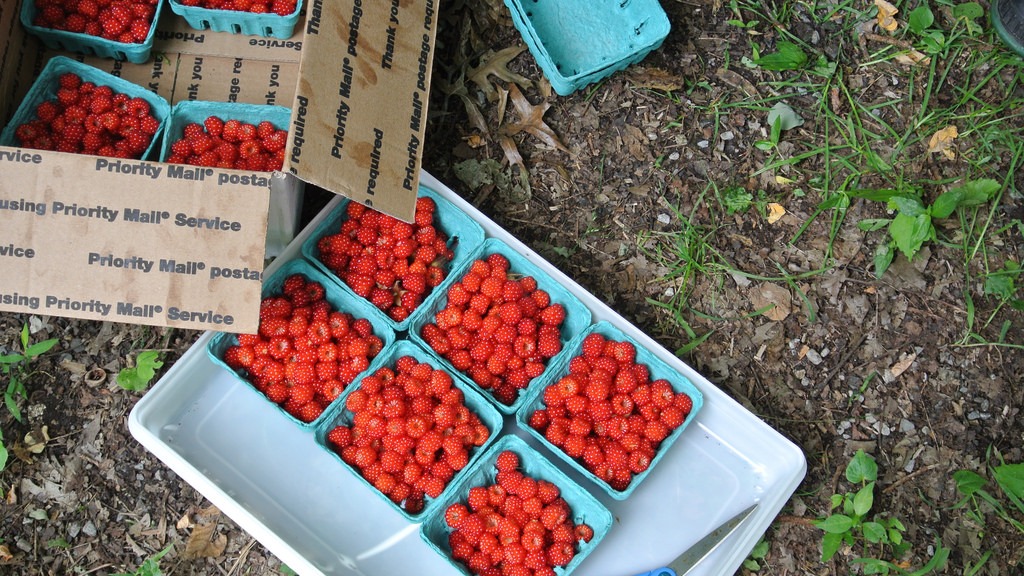Foraged vegetables are always more fun to cook. So Food52’s resident forager, Tama Matsuoka Wong, is introducing us to the seasonal wild plants we should be looking for, and the recipes that will make our kitchens feel a little more wild.
If you’ve ever found a blueberry or a black raspberry on the side of a trail and popped it in your mouth, you’ve been foraging. Although it’s more convenient to “forage” farmers markets or grocery aisles for cultivated berries, I love the intense flavor of wild berries, as well as the fun of picking them in their natural habitat. Here is a rundown of some of the summer season’s most common wild berries:
Aggregate berries: Raspberries, blackberries, and wineberries
Aggregate berries are distinguished by their tightly packed clusters of fruits, known as carpels. The most common example is the raspberry, which is really a bunch of tiny red fruits clustered together. This sort of formation is a good thing, because each little fruit droplet on its own would hardly be enough for a mouthful!
These berries belong to the rose family, and grow on long arching “canes” that often form dense, brambly thickets. Much like roses, their bristles and thorns can make picking a somewhat prickly adventure — so be prepared!
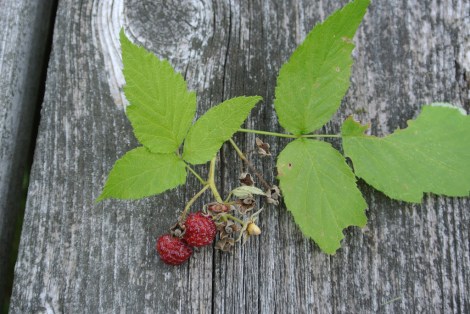
Tama Matsuoka Wong
- Wild red raspberries, or Rubus strigosus (above), can be found throughout North America, excluding the Deep South. Unfortunately, I sometimes find that wild raspberries can be quite seedy and dry, depending on the place and the weather. Black raspberries — the eastern Rubus Occidentalis and the western Rubus leucodermis — are native to North America and are found from mid- to late summer.
- When you pick a raspberry from its plant, it leaves behind a small white cone — that’s the “receptacle,” which attaches the fruit to the cane. The blackberry cone receptacle, on the other hand, remains attached to the fruit, which explains why blackberries are flat where they connect with the plant, while raspberries have that hollow bit where the cone once was.
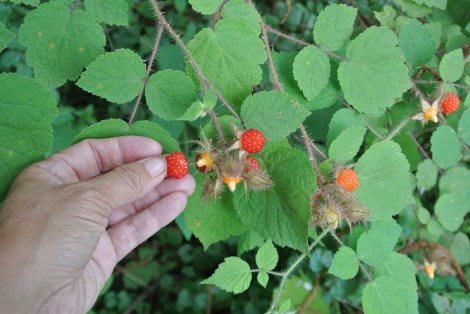
Tama Matsuoka Wong
- The Asian wineberry, or Rubus phoenicolasius (above), grows on the shady edges of woods throughout most of North America, and is easy to identify because it has very fuzzy, thorn-less canes. Some wineberries are more tart than others, but they all have an incredibly fresh taste and a ruby-colored, jewel-like shine. The fruit emerges from fuzzy cases — which almost look like Christmas lights — which slowly open to reveal bright red berries. Like raspberries, they leave behind a small, white, cone-shaped receptacle when picked. Since wineberries are invasive, I never hesitate to hack away at their canes like a lumbering bear.

Tama Matsuoka Wong
- Mulberries (above), often found on old farms and in backyards, are also aggregate berries, but they grow from trees. The entire fruit is joined to the stem directly, so there is no white receptacle left behind when they’re picked. The indigenous mulberry tree, Morus Rubra, has been hybridized with the Morus Alba tree from Asia, and now bears both white and red fruit.
“Crown” berries: Blueberries, huckleberries, and juneberries
Wild blueberries and huckleberries are in the Heath family, and grow as bushes or shrubs in soils with low acidity levels. While these are all bluish in color, the key identifier is that the edible blueberries all have a crown at one end.
- Wild blueberries (below) look very similar to the store-bought variety, except they’re much smaller and less plump. What they lack in girth they make up for with incredible flavor: After I’ve been eating a lot of wild ones, I find cultivated blueberries taste bland and watered down.
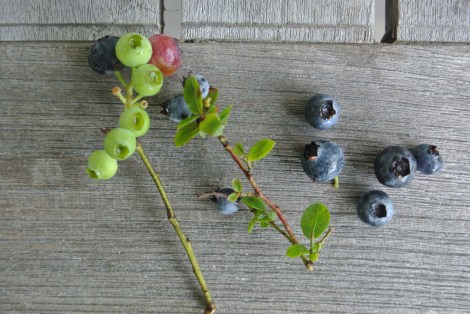
Tama Matsuoka Wong
- Huckleberries are quite small, though their seeds are larger than those of blueberries and tend to stick to your teeth. My friend, West Coast-based forager Connie Green, swears by coastal huckleberries, which take on a deep flavor in September. While huckleberries have had a couple of difficult years due to droughts, she reports that this year looks more promising.
- Juneberries, also called serviceberries, are bluish-purple berries that have a crown at one end but grow from trees rather than bushes. The Amelanchier canadensis variety grows wild on the East Coast, while the Amelanchier alnifolia, known as saskatoons, are prevalent in the Pacific Northwest. These berries are plump and juicy, with a sweet-tart taste; like aggregate berries, they are also a part of the rose family. They make great jam, especially when mixed with rose petals.
It is important to note that there are several varieties of poisonous berries: Pokeweed, privet, honeysuckle vine berries, nightshade, and Japanese honeysuckle are all blue or purple in color; red-colored poisonous berries include bush honeysuckle and yew. Neither are aggregate fruits, nor do their berries have crowns. Always be sure to identify your plants, and do not just pop any old berry into your mouth as an experiment.
After a day spent foraging (and gobbling) berries in the woods, the last thing I want to do is spend a lot of time cooking, which is exactly why I tend to rely on store-bought pie crust for this incredibly simple pie. The pie is all berry, so their wild flavors shine through. It gets its zing from a bit of lemon and cassis, a trick I learned from my friend Betsy. It is also very flexible in terms of berry-to-berry ratios, so if I’ve eaten up most of the blueberries, I can just add more wineberries, and so on.
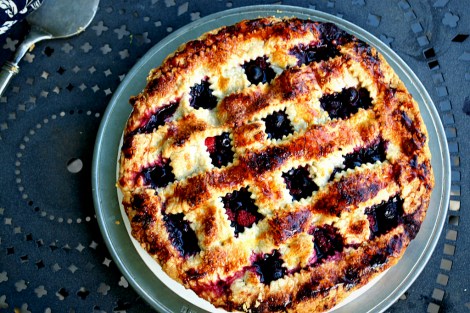
Mia Wong
Mixed Wild Berry Pie with Cassis
See the full recipe (and save it and print it) here.
Makes one double-crust 9-inch pie
1 double pie crust (your favorite recipe, or store-bought)
5 cups mixed wild berries (I used 2 cups wineberries, 2 cups wild blueberries, and 1 cup mulberries)
1/2 cup sugar
1/4 cup cassis
Juice of half a lemon
Zest of 1 lemon
1/3 cup flour
Fruit jam (we used wineberry-blueberry jam from last year)
1 egg yolk (optional)
Raw sugar (optional)

